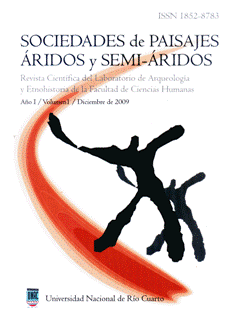POR LA RUTA DEL AGUA EN LA PUNTA DE MAISI, GUANTANAMO, CUBA. UN ESTUDIO DE FUNCIONALIDAD EN EL ARTE RUPESTRE
Resumen
Resumen
Se presentan algunos resultados obtenidos del análisis de la relación estaciones rupestres – fuentes de aguas, en la región Punta de Maisí, extremo más oriental de Cuba, caracterizada por un clima tropical semi-desértico que según las investigaciones paleoclimáticas más recientes pudo estar acrecentado durante los efectos, de la denominada en el continente europeo «Pequeña Edad de Hielo», provocando niveles de precipitaciones muy inferiores a los actuales durante los siglos XIV al XVII , estos datos llevados al análisis de su implicación dentro de la sociedades humanas que poblaron estas tierra entre el 1000 y el 1600 dne y su vinculación con la distribución y características de sus obras rupestres permiten afirmar que para estos grupos era esencial regular determinadas acciones y mediante ellas mantener la conducta social de la comunidad en el uso y/o abuso del abasto de agua, garantizando con el arte rupestre la protección, ubicación y explotación de este preciado líquido; del cual dependía la supervivencia biológica e ideológica de la comunidad.
Palabras claves: Arte Rupestre – Petroglifos – Agua - Clima Tropical.
Abstract
In this paper you can find some results obtained for the analysis of the relationship between rock art sites and water resourses in Punta de Maisí, in the Easter side of Cuba. This region has a characteristic semi-desertic tropical clime, wich could be increased by the efects of the known in Europe as «Little Ice Age», which caused in XIV to XVII centuries rain levels lower than the actual ones. Analysing the implications of these data over the human societies that inhabited these lands between 1000 to 1600 centuries AD and its relationship between the distribution and characteristics of their rock arts, it allows us to afirmate that for these groups, it was esential to control some actions and to keep in order the community´s social behaviour in the use and/or waste of the water resources, guaranteing with the rock art, the location, protection, and explotation of water, to help the community to survive physical and psychologically.
Key words: Rock Art – Petroglyphs – Water - Tropical Clime
Descargas
Publicado
Número
Sección
Licencia
Aquellos autores/as que tengan publicaciones con esta revista, aceptan los términos siguientes:- Los autores/as conservarán sus derechos de autor y garantizarán a la revista el derecho de primera publicación de su obra, el cuál estará simultáneamente sujeto a la Licencia de reconocimiento de Creative Commons que permite a terceros compartir la obra siempre que se indique su autor y su primera publicación esta revista.
- Los autores/as podrán adoptar otros acuerdos de licencia no exclusiva de distribución de la versión de la obra publicada (p. ej.: depositarla en un archivo telemático institucional o publicarla en un volumen monográfico) siempre que se indique la publicación inicial en esta revista.
- Se permite y recomienda a los autores/as difundir su obra a través de Internet (p. ej.: en archivos telemáticos institucionales o en su página web) antes y durante el proceso de envío, lo cual puede producir intercambios interesantes y aumentar las citas de la obra publicada. (Véase El efecto del acceso abierto).

